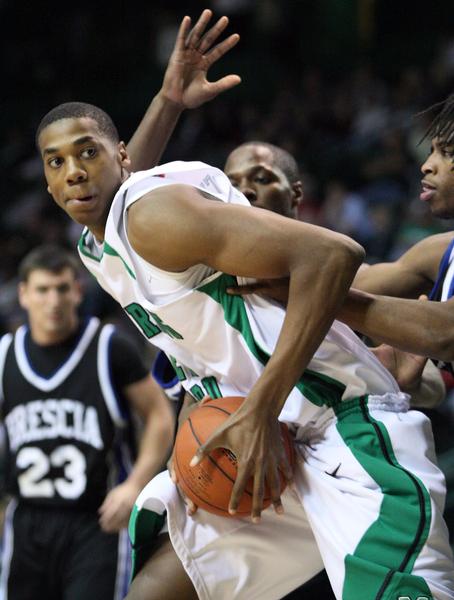Posted by rtmsf on June 27th, 2007
Thanks to everyone who took a few moments to look at our post from yesterday – NBA Draft Picks by School (1949-2006). There was an overwhelming response, and we appreciate all the commentary and advice, which is how we learn how to manage this thing a little better day-to-day.
First, let’s address a couple of the points we heard from you via email, msg boards and commentary.
- The “modern draft” refers to the era in which the NBA began using a round-by-round system. Even though there was an NBA Draft in 1947 and 1948, the round system did not begin until 1949, which is why we decided to start there.
- Following up on that point, we also chose to only review the first two rounds of the NBA Draft during this period. The current version (two rounds) began in 1989, and after a cursory review of the “extra” rounds – which totaled as many as twelve over this era, we realized very quickly that the vast majority of the players drafted in rounds 3+ never saw action in the NBA. For that reason, we decided to focus solely on the first two rounds.
Now, on with the data. We promised a breakdown by round and by decade, and we’ll deliver on half of that promise today. We also have sliced the first round into a “Top 10” and “Top 5” pick column, just for kicks. See Table B below.
Table B. NBA Draft Picks by School & Round Taken (1949-2006)
Notes: this table is sorted by the 1st Rd column, and is limited to schools with six first round picks since 1949. The yellow shading refers to the highest value in that column.

Observations:
Super Six. Remember what we were saying about the so-called Super Six yesterday? Well, these six schools – UNC, Duke, UCLA, Kentucky, Indiana and UCLA – take a larger piece of the action the higher up the draft board we go. They collectively comprise 13.4% (149 of 1115) of the all-time first-rounders, 14.8% of the top 10 picks (86 of 580), and 17.6% of the top 5 picks (51 of 290). In other words, more than a sixth of the top 5 picks in history came from one of the above six schools.

With Studs Like These, How do They Ever Lose?
Blue Heaven. The school with by far the most first-round picks, the most top 10 picks, and the most top 5 picks clearly resides in Chapel Hill. Let’s put this in perspective. UNC has had more top 5 picks than all but ten schools have had first round picks. It accounts for 6.2% of the top 5 picks in history all by itself, and dominates each of the above categories. That’s unbelievable. Nobody can ever say that Carolina hasn’t had a surplus of talent. Maybe that criticism of Dean Smith “only” winning two national titles at UNC has some legs after all.
Who doesn’t belong? Notre Dame, and again, Minnesota, seem to be the extreme outliers here. Was Digger Phelps really so bad of a coach that the Irish can produce twenty first-rounders (fifth on our list) and five top 5 picks but ND has only been to one F4 in its history? Guess so. We still can’t figure out Minnesota either. The Gophers are behind only UNC, Duke, UCLA and Kentucky in all-time top 10 picks. All we can guess is that Whitey Skoog, Ed Kalafat and Dick Garmaker must have been tremendous players back in the day. Also, a tip of the hat to Alabama and Missouri for producing a combined 27 first-rounders with nary a F4 to show for it. Nice work, gents.

Digger Must Have Been Even Worse as a Coach
We have a lot of good, but not great, players. The second round is always a fascinating hodgepodge of players who may have been fine collegians but were undersized, overslow or otherwise fraught with concerns about their transition to the League. Nothing says slow like Indiana, who coincidentally leads the way with 22 second round picks. Of course, Arizona follows up with 20 and UCLA with 19 second-rounders, so maybe that theory is a little half-baked. Nevertheless, it was cool to see the schools that consistently produce top talent vs. mediocre NBA talent (in the eyes of the GMs, at least). For UNC, it’s first round or bust, mostly (81% of its draftees went in the first round); for a school like LSU, either you’re drafted in the top 5 (8 of its 12 first-rounders) or you’re likely to end up in the second round (11 of the remaining 15 picks). One other neat example is Utah, where 9 of its 10 first-rounders went in the top 10 picks – maybe praying to Joe Smith (not the former Terp) or whatever it is that they do out there for a high NBA pick only works if you’re taller than 6’9 (e.g., Andrew Bogut, Keith Van Horn, Tom Chambers, Bill McGill).

Evidence that Penn St. Basketball Exists
Who is missing? Several schools with some solid history, including Marquette (5 first-rounders and 14 (!!) second-rounders), Pittsburgh (4/4), Xavier (4/6), Gonzaga (3/3) and UTEP (3/8), didn’t make our cut. Just for fun, the BCS schools with the least successful draft histories belong to… South Florida (only one second-rounder) and Penn State (two second-rounders). USF we understand – they’re new to the Big East and all – but Penn State? – that school has been in the Big 10 for almost fifteen years. That’s pathetic.
Coming Next: the final installment will take a look at draft picks by decade, so we can see how things have trended over the years. Which schools have consistently supplied talent to the NBA and which have long since passed or are rising fast? View Part III here.
| nba draft, rtc analysis
| Tagged: alabama, andrew bogut, arizona, bcs, big 10, big east, bill mcgill, dean smith, digger phelps, duke, final four, first round, gonzaga, indiana, joe smith, kansas, keith van horn, kentucky, lsu, marquette, minnesota, missouri, nba draft, notre dame, penn st, pittsburgh, second round, south florida, tom chambers, top 10 pick, top 5 pick, ucla, unc, utah, utep, xavier
Share this story
















































